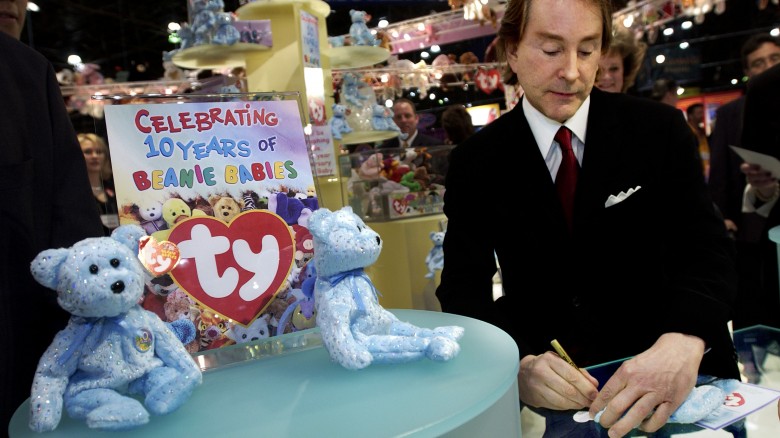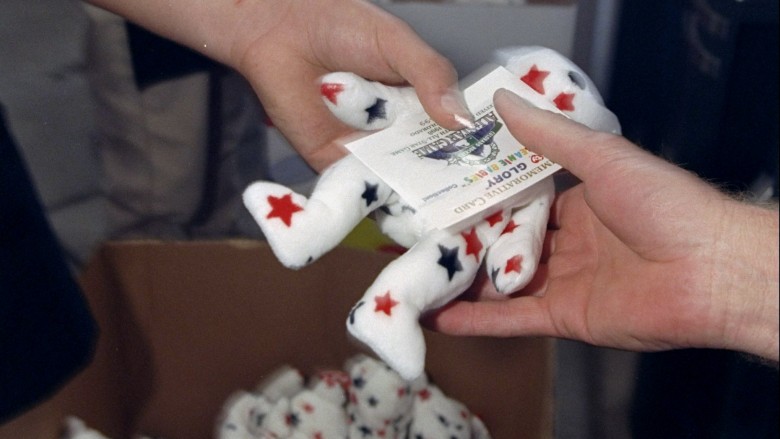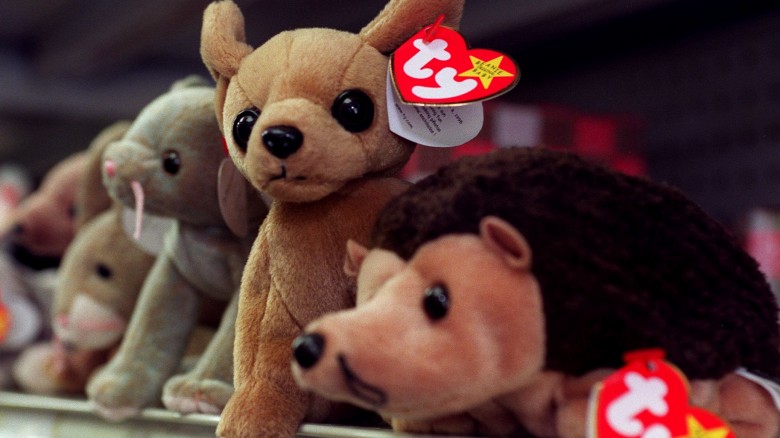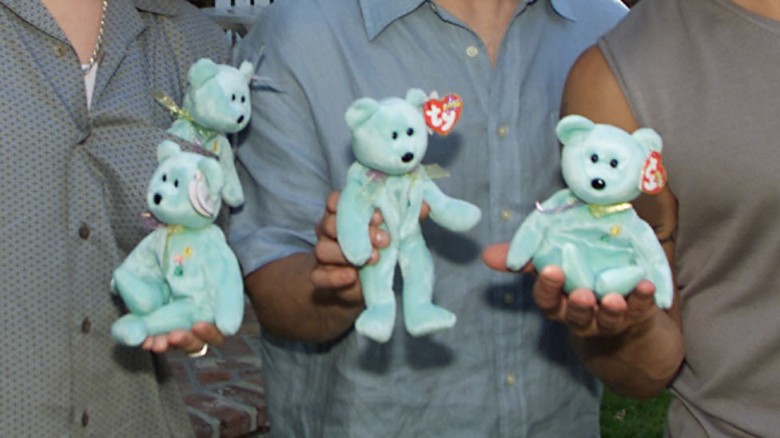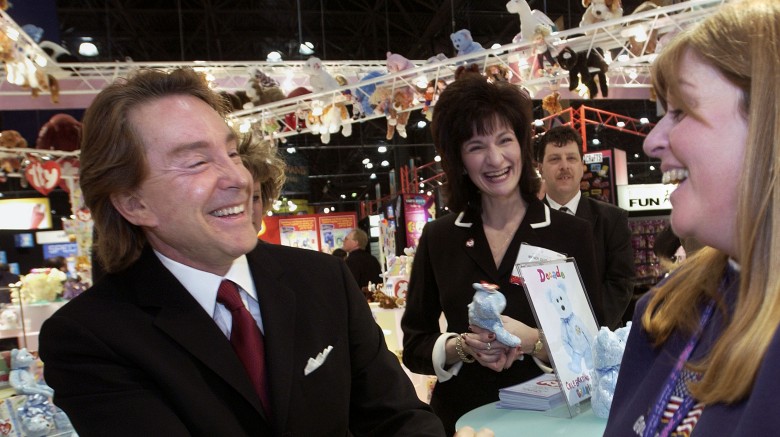The Real Reason Why Beanie Babies Disappeared
Anyone from the '90s will remember the godawful Beanie Babies craze. For a period of a few years, consumers collectively lost their minds over cheaply produced, nifty stuffed animals which quickly became one of the bestselling franchises of all time. They went from being cheap, last-minute stocking-stuffers, to the primary assets of many people's investment portfolios. The value of Beanie Babies rose to outrageous highs, before crashing and languishing on the shelves of hospital gift shops. Now they serve as a reminder of why we shouldn't treat cutesy stuffed animals like the solution to all life's problems.
Beanie Babies was a manufactured fad
It takes a diabolical mind to create a $6 billion empire, and that's exactly what Ty Warner had when he introduced Beanie Babies. Originally, other toy companies mocked Warner like he was the awkward new kid in class. However, Warner persevered, because he not only knew how to make toys — he had an incredibly cold and calculated business plan. He made Beanie Babies on the cheap — most were sold for just $5, making them easy for children to buy and even easier for adults to purchase impulsively. Also, he knew where to sell his product. He deliberately chose not to sell them at large retailers like Walmart, to create the illusion of exclusivity.
Furthermore, the Beanie Babies were personified with tags containing names and poems, which made them more enduring to children. Warner also knew to manipulate demand, like some kind of money-grubbing puppeteer. He would randomly retire certain lines of Beanies, creating an artificial shortage because, you know, supply and demand or something like that. This scarcity would only drive more purchases. Warner most famously used this tactic in 1999, when he announced that he was intending to retire Beanie Babies, which caused a fervor on the early Internet and the market place.
They became a commodity
For those who don't already know, toys have long been valuable treasures stuffed in your mother's attic. For instance, a toy from decades past might be worth several thousand dollars to collectors, simply because of its rarity or nostalgia, and this what many thought Beanie Babies might become. Rumors began to spread that they might become such cash cows in the future, and that's all it took for Beanie Babies to become velveteen gold mines. Adults lined up to buy as many as possible so they could secure their financial future rather than, say, an ACTUAL RETIREMENT PLAN.
Beanie Babies had become such a widespread phenomenon by 1999, that at least 60% of all American households had them. However, they didn't exist simply as cuddly knick-knacks for children — they were also cold hard investments to be taken seriously, rather than laughed off as the insanity they really were. Like gold or silver, they became a commodity to be held onto until their eventual rise in price ... but it wasn't to be. Though some fortunate sellers did see an enormous return on their investment, the vast majority did not, since the inevitable bubble did pop. However, there were some interesting stories that emerged during the time the bubble was still expanding.
The fad became a dangerous bubble
Financial bubbles occur when a product begins to rapidly rise in value until it eventually pops, causing destitution to all those involved. Some bubbles, like the housing bubble that eventually burst in 2008, are reasonable. After all, a house is actually, you know, a useful thing to have — others, like the fabled Tulip-mania in the Netherlands, are just totally stupid. The Beanie Babies bubble was the latter. As the value of Beanies began to rise, people dropped hundreds of thousands of dollars to try and get a piece of the action. Since the Beanie Babies bubble occurred nearly twenty years ago, many have forgotten how seriously some unfortunate people took it.
One couple who divorced in 1999 actually had to take their Beanie Babies collection (valued between $2500 and $5000) to the courtroom so a judge could divide it fairly, since they were unable do it themselves. There's also the story of Chris Robinson, whose father became obsessed with collecting Beanie Babies and planned to use them in the future to pay his son's college tuition. At the time, it seemed reasonable, since collector's manuals were showing rosy projections for the future, while rarer models of the toys were selling for ten times their value. In the end, it led to financial destitution, after Robinson's father spent a freaking $100,000 on 20,000 Beanie Babies that are now worth just pennies on the dollar. The whole Beanie Babies fad isn't so innocent anymore, now is it?
But, wait, it gets even worse ...
It spawned a criminal enterprise
By the late '90s, Beanie Babies had created such a commercial stir, it became profitable for criminals to try to exploit them. Keeping in mind that Beanie Babies were supposed to just be children's plush toys, let's look over the atrocities committed over them.
Some of the Beanie Babies were worth as much as 1000% as their original value, so counterfeit Beanie Babies became a viable industry. In 1997, 456 counterfeit Beanie Babies were seized from O'Hara National Airport, while another 17,000 were discovered in Orlando, Florida around the same time. Beanie Baby fraud soon became an entire industry unto itself, with one woman from Pensacola, Florida making $12,000 from selling non-existent Chilly the Polar Bear figures.
However, the epitome of Beanie Baby crimes occurred in October 1999, when a man named Jeffrey White murdered a co-worker of a couple hundred dollars worth of Beanie Babies. He was apparently frustrated with his victim over a Beanie Baby trading exchange (whatever that's supposed to mean) and decided murder was the best option.
Ty Warner only contributed even more to the insanity, since he himself engaged in borderline illegal tactics with merchants over his products. One store owner in Connecticut recognized the fad early on, and sold over fifty thousand Beanie Babies, when a representative from the Ty toy company told him that if he wanted to keep getting shipments of Beanie Babies, he would have to buy at least $10,000 worth of other, less successful merchandise. The store owner aptly summed up the experience: "I felt like the Mafia was leaning on me." Pretty much — trying to discuss the Beanie Babies industry is like trying to describe the plot of a bad gangster movie.
Beanie Babies "analysts" made fortunes
Being a financial analyst is a very specialized profession requiring years of training to properly observe the subtle trends of the markets. However, when it came to Beanie Babies analysts, it was a mish-mash of actual professionals and hobbyists who turned their love for the toys into profit. Peggy Gallagher was one such hobbyist, who got the Beanie Babies bug and proceeded to dedicate her life to the subject. In 1997, she wrote the book The Beanie Babies Phenomenon, which sold 77,000 copies and netted her $200,000. Afterwards, she became one of the first official Beanie Baby authenticators, due to the rise of counterfeit stuffies.
Even more successful was Mary Beth Sobolewski, a former IBM systems engineer who used her computer expertise to collect data from phone surveys and online sales, to make the Beanie Babies market's most influential pricing list. After turning the Beanie Babies business into a mock stock market, Sobolowski was approached by a Chicago publisher to become the editor-in-chief of Mary Beth's Beanie World magazine, which was essentially the Wall Street Journal of overpriced stuffed animals. At its peak in 1998, the Beanie World magazine had a jaw-dropping circulation of 650,000, and was regarded as the Bible of Beanie Babies collectors. Everything seemed fine and dandy until Ty Warner brought about the end of days, when he announced the "retirement" of Beanie Babies in 1999.
The crash was inevitable
We've already covered Ty Warner's fake-out, when he said he'd stop making Beanie Babies, but there's more to the story. Warner had ulterior motives besides just stopping production of the toys that made him a billionaire — he was testing the waters, to see what the consumer attitudes were. It turned out that, by 1999, children no longer wanted Beanie Babies. They had long since lost interest and had moved on to fads like Pokemon, which was sweeping the planet. Beanie Babies were no longer a toy — they had officially entered the territory of pure speculation or pure insanity — take your pick.
Adults who (thought they) couldn't afford food were buying shopping carts full of Beanie Babies, because they figured the toys were only going to skyrocket in value — you can probably see where this going. At first, only about 10% of Beanie Babies were being sold to these kinds of speculators — that number rose to almost 100% by 1999. The "retirement" announcement only made things worse, since people began to believe that it was their last-ever chance to buy as many Beanies as they could carry. When people came to their senses and realized just how stupid the obsession with Beanie Babies was, the prices tumbled.
But whatever happened to Ty Warner, the guy who brought upon us the scourge of Beanie Babies? Well, his story has been just as crazy as the fad he made ...
Ty Warner's sad post-Beanie Babies life
Okay, so now you might be wondering what Ty Warner's been up to since the Beanie Babies craze ended. Well, his story's been just as crazy as the fad he created — he's become extremely reclusive and hasn't given an interview since 1999, which was also the year that he bought the Four Seasons New York hotel for $275 million. To be fair, an action like that made a far bigger statement than any soundbite ever could. Oddly enough, though, the same guy who could drop over a quarter billion dollars on a hotel stashed away $5 million in offshore accounts for which he would be convicted of tax evasion and given probation.
What about Warner the man? He's had a series of girlfriends, none of whom have been permanent. Those who have worked with him have described him as "selfish", "stingy", and "arrogant", which kind of makes since considering, he was willing to squirrel away a measly $5 million (by the time he was caught, the amount had ballooned to $100 million) to escape an ultimately inconsequential amount of tax. He's also had numerous plastic surgeries which have left him looking more or less ... scary. Since his tax evasion conviction in 2014, he's pretty much disappeared from the world.
So, there you have it — the guy's gone off his rocker and is basically the Phantom of the Opera. He's a billionaire, though, so he probably doesn't give one single bean what we think.

